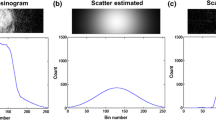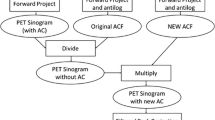Abstract
We have improved the calculation of the brain attenuation correction in positron emission tomography (PET) and set up a procedure which allows the clinician to get a fully corrected image in a single reconstruction step, without human intervention. By using a general object description scheme based on polygonal contour trees we are able to calculate the attenuation correction for brain tissue, bone and head holder. The head contour is generated from the emission sinogram. On a set of 15 adult patients, the emission values obtained using this calculated attenuation compare favorably with those obtained with an attenuation resulting from a transmission measurement. Residual discrepancies are attributed to incomplete scatter compensation between emission and transmission. The robustness of the algorithm has been tested on more than 100 brain fluorodeoxyglucose (18FDG) studies in adult patients, including pathological cases. Its applicability for18FDG studies in children and for other tracer such as water (H2 15O) and fluoroethylspiperone (18FESP) is also presented.
Similar content being viewed by others
References
Bergström M, Litton J, Eriksson L, Bohm C, Blomqvist G (1982) Determination of object contour from projections for attenuation correction in cranial positron emission tomography. J Comput Assist Tomogr 6:365–372
Bergström M, Eriksson L, Bohm C, Blomqvist G, Litton J (1983) Correction for scattered radiation in a ring detector positron camera by integral transformation of the projections. J Comput Assist Tomogr 7:42–50
Casey M, Hoffman EJ (1986) Quantitation in positron emission tomography: 7. A technique to reduce noise in accidental coincidence measurements and coincidence efficiency calibration. J Comput Assist Tomogr 10:845–850
Chan B, Bergström M, Palmer MR, Sayre C, Pate BD (1986) Scatter distribution in transmission measurements with positron emission tomography. J Comput Assist Tomogr 10:296–301
Cho ZH, Chan JK, Eriksson L, Singh M, Graham S, MacDonald NS, Yano Y (1975) Positron range obtained from biomedically important positron-emitting radionuclides. J Nucl Med 16:1174–1176
Dahlbom M, Hoffman EJ (1987) Problems in signal-to-noise ratio for attenuation correction in high resolution PET. IEEE Trans Nucl Sci NS-34:288–293
Derenzo SE, Budinger TF, Huesman RH, Cahoon JL, Vueltich T (1981) Imaging properties of a positron tomography with 280 BGO crystals. IEEE Trans Nucl Sci NS-28:81–89
Friedman JH (1974) Data analysis for high energy particle physics, proceeding of the CERN School of Computing, Godoysund. Norway (CERN Report 74-23)
Germano G, Hoffman EJ (1988) Investigation of count rate and deadtime characteristics of a high resolution pet system. J Comput Assist Tomogr 12:836–846
Gonzalez RC, Wintz P (1987) Digital image processing, 2nd Ed. Addison-Wesley, Reading, MA
Huang SC, Hoffman EJ, Phelps ME, Kuhl DE (1979) Quantitation in positron emission tomography: 2. Effects of inaccurate attenuation correction. J Comput Assist Tomogr 3:804–814
Huang SC, Carson RE, Phelps ME, Hoffman EJ, Schelbert HR, Kuhl DE (1981) A boundary method for attenuation correction in positron computed tomography. J Nucl Med 22:627–637
Huesman RH, Derenzo SE, Cahoon JL, Geyer AB, Moses WW, Uber DC, Vuletich T, Budinger TF (1988) Orbiting transmission source for positron tomography. IEEE Trans Nucl Sci NS-35:735–739
Hoffman EJ, Phelps ME, Huang SC, Collard PE, Bidaut LM, Schwab RL, Ricci AR (1986) Dynamic gated and high resolution imaging with the ECAT III. IEEE Trans Nucl Sci NS-33:452–455
Hosoba M, Wani H, Toyama H, Murata H, Tanaka E (1986) Automated body contour detection in SPECT: effect on quantitative studies. J Nucl Med 27:1184–1191
King PH, Hubner K, Gibbs W, Holloway E (1981) Noise identification and removal in positron imaging systems. IEEE Trans Nucl Sci NS-28:148–151
Kretschmann HJ, Weinrich W (1986) Neuroanatomy and cranial computed tomography, 1st Ed. Thieme, Stuttgart, New York
Press WH, Flannery BP, Teukolsky SA, Vetterling WT (1986) Numerical Recipes — The Art of Scientific Computing, Cambridge University Press, Cambridge
Tomitani T (1987) An edge detection algorithm for attenuation correction in emission CT. IEEE Trans Nucl Sci NS-34:309–312
Author information
Authors and Affiliations
Rights and permissions
About this article
Cite this article
Michel, C., Bol, A., de Volder, A.G. et al. Online brain attenuation correction in PET: towards a fully automated data handling in a clinical environment. Eur J Nucl Med 15, 712–718 (1989). https://doi.org/10.1007/BF00631762
Issue Date:
DOI: https://doi.org/10.1007/BF00631762




